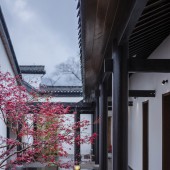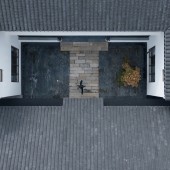The Ancestor House Hotel by Chen Xiao and Chen Dilong |
Home > Winners > #101465 |
 |
|
||||
| DESIGN DETAILS | |||||
| DESIGN NAME: The Ancestor House PRIMARY FUNCTION: Hotel INSPIRATION: Globalization and rapid urbanization promise better lives, but also widen the gap between rural and urban regions. We may say, rural China is in a terrible predicament of identity anxiety and cultural deficiencies. In this dual situation, how can architects do to “urbanize the countryside" sustainably, raise the status of rural areas, and inspire rural self-confidence? We think the best solution to rural revitalization would never be building new houses over old ones. The most appropriate yet difficult way of Chinese rural construction is one that makes people feel at ease in the space without deliberate interference nor a imitation of the ancient, as described by a famous saying in Tao Te Ching by Lao Tzu: “ A great sound is inaudible,and a great image is formless. UNIQUE PROPERTIES / PROJECT DESCRIPTION: The return to pastoral life has long been an ideal of Chinese literary tradition and turned into nostalgia for rural lands. The property was the family mansion first built in 1898 by Zhou Ansheng, the grandfather of the client who tasked us for the renovation. However, it has been largely derelict for decades since the family members left hometown for better living. The original building was a traditional Chinese courtyard dwelling — three-hall structure with two wings and four internal courtyards. Except for the characteristic Huizhou-style facade and roof which are well preserved, most of the other original features — the loam walls, wooden roof trusses, timber beams and columns, grey tiles are severely damaged. Under such condition, the building might seem to be of little value to some villagers, but for Zhou’s family, it is a century-old dream and memory. Also for us, it was just like an uncut jade to be carved into great works. OPERATION / FLOW / INTERACTION: Before getting down to the renovation work, the designers and craftsmen checked the status of the timber structure and walls, and decided on renovation methods for the most crucial parts, including the roof, the timber frame and the exterior walls. On the roof, only one layer of small black tiles were laid for rain proof, where lots of leakage points could be found. As a result, new timber roof boarding and waterproof membranes would be laid underneath the tiles. As for the main structure, the pillars and most main beams were severely damaged, so most of them need to be rebuilt. For us, the architecture itself should be like the one born in the earth. We think the best solution to rural revitalization would never be building new houses over old ones, not to mention undisciplined occupation of land. PROJECT DURATION AND LOCATION: Design Phase:2017.3-2018.7 Construction:2017.11-2019.11 Project Location: Zhouwujie Village, Changxing County, Huzhou City, Zhejiang Province FITS BEST INTO CATEGORY: Architecture, Building and Structure Design |
PRODUCTION / REALIZATION TECHNOLOGY: After discussion, we made it a priority to restore and repair the existing building, keep the original spatial layout, revive the sense of sophistication and stateliness that existed when the original property was first built, an ode to its past. As a result, the original structure of Huizhou-style façade and walls were revamped and reinforced by steel-concrete structure so as to eliminate air/wind leakage and potential structural risks. The severely damaged through type timber frame were rebuilt according the original structure. Some undamaged beams and stone plinths under the wooden pillars were kept intact, the demolished ones such as grey tiles are recycled for pavements and roof decoration, echoing the history to the house and the local culture on the tectonic side as well as showing sustainable ecological construction philosophy. We are fortunate to work with timber structure engineers and excellent local craftsman, which are exceedingly difficult to find given the exodus of local labor from countryside to big cities for their living. The disadvantage of traditional courtyard dwelling layout is insufficient of light, thus a side wall of the lobby had to be replaced by glass screen walls to bring in light. The transparency also enhanced the connectivity between the indoor spaces and the open courtyard. Stepping into the lobby through the low robust rubble wall and a stone-paved courtyard embellished with two local red plum trees, the family-style setup is perfect for those who want quietude, away from the bustling city. The interiors consist of two ideas, simplicity and space. We brought in few pieces of furniture with simple lines, good quality and extremely polished, which perfectly fuse different hues and texture. Wooden grills and local limestone floor merged together to create a sense of warmth, naturalness. The new reflects the past without imitating it. The back hall connects the two floors and with an exquisite wooden stair and provides access and privacy for all the 14 rooms. The two courtyards divide the spatial patters and create various circulation route, providing a playful walking experience as well as impressive views. SPECIFICATIONS / TECHNICAL PROPERTIES: Floor Area:1202㎡ TAGS: Architectural Design, Interior Design, Landscape Design, Adaptive Re-Use, Hotel, Residence, RESEARCH ABSTRACT: Courtyards are spiritual place for Chinese ancient literati, and still a longing place for urbanite where they can be assured of being personally pampered in beautiful rural surroundings to get away from the hustle and bustle. Famous Chinese writer Lin Yutang, also best known is the West for his English writing once described his ideal home:“Garden within a house, house within a garden, courtyard among rooms, trees among courtyard, sky above trees, moon in sky”, reflecting the most distinctive feature of Chinese home design of all ages is the stone-paved courtyard, just similar in effect to a Spanish cloister, and symbolizing peace, quiet and repose. CHALLENGE: There were always gaps between the ideal of design and the reality of the craftsmen’s experience and techniques, for example, at first, we would like to do antique finish of the facade wall to show the history of the house, but with several rounds of negotiation and mutual compromises, it turns out to be fresh white. Anyway, for our design team, this project was a most thorough practice of our “buildingless” approach. The completion of the project hasn’t left a sign of new building on the village, but the landscape at the village entrance, the alleys around the house, and the interior and exterior spaces of the building, were all more harmonious with the people’s life and the village, and more friendly to visitors from outside. This project has inspired some in-depth thinking in us. The “architecture without architects” in rural areas has revealed a specific situation where it was very hard for architects with trained ways of thinking to truly “root” himself in the village, for his trained experience was not necessarily what was needed there. Our intention for the project of “buildingless building” was to provoke reflection and improvement of the simple “architecture without architects” in villages, to avoid applying experiences of our practices in cities directly to rural projects, especially taking the projects as shows of personal styles. In our opinion, the most appropriate way of today’s village construction should be one that makes people feel at ease in the space without deliberate interference, as described by a famous saying in Tao Te Ching by Lao Tsu:”A great sound is inaudible, and a great image is formless.” Undoubtedly, this is a rural form that is expected by metropolitans. In the context of China's “beautiful villages” and “village rejuvenation”, Changxing, as one of the main positions for the revitalization of the rural areas in Zhejiang Province, has been formulated in various aspects such as strengthening capital investment, housing system reform, and rural human settlements. With nearly 40 supporting policies and measures, we have reason to expect this new model to attract interesting people to gather, nourish the rural ecology and develop healthily.In the near future, we believe, lots of characterful country house hotels would follow. ADDED DATE: 2020-02-27 02:35:08 TEAM MEMBERS (8) : Design Firm: Yushe Design & JAZ BUILD, Principal Architect:Chen Xiao、Li Zhiqiang、Xu Yi、Gao Shantong, Architectural Design:Li Na、Pang Di、Liang Xiuzhu, Interior Design:Mao Lili、Chen Peng、Zhao Xikang, Landscape Design:Yu Haoyan、Chen Jingfeng、Ma Jiang, Timber Frame Design and Construction: Chen Dilong、Li Juan、Huang Limin, and IMAGE CREDITS: Photography: Fancy Image |
||||
| Visit the following page to learn more: https://www.yushe-sh.com | |||||
| AWARD DETAILS | |
 |
The Ancestor House Hotel by Chen Xiao and Chen Dilong is Winner in Architecture, Building and Structure Design Category, 2019 - 2020.· Read the interview with designer Chen Xiao and Chen Dilong for design The Ancestor House here.· Press Members: Login or Register to request an exclusive interview with Chen Xiao and Chen Dilong. · Click here to register inorder to view the profile and other works by Chen Xiao and Chen Dilong. |
| SOCIAL |
| + Add to Likes / Favorites | Send to My Email | Comment | Testimonials | View Press-Release | Press Kit |
Did you like Chen Xiao and Chen Dilong's Architecture Design?
You will most likely enjoy other award winning architecture design as well.
Click here to view more Award Winning Architecture Design.








